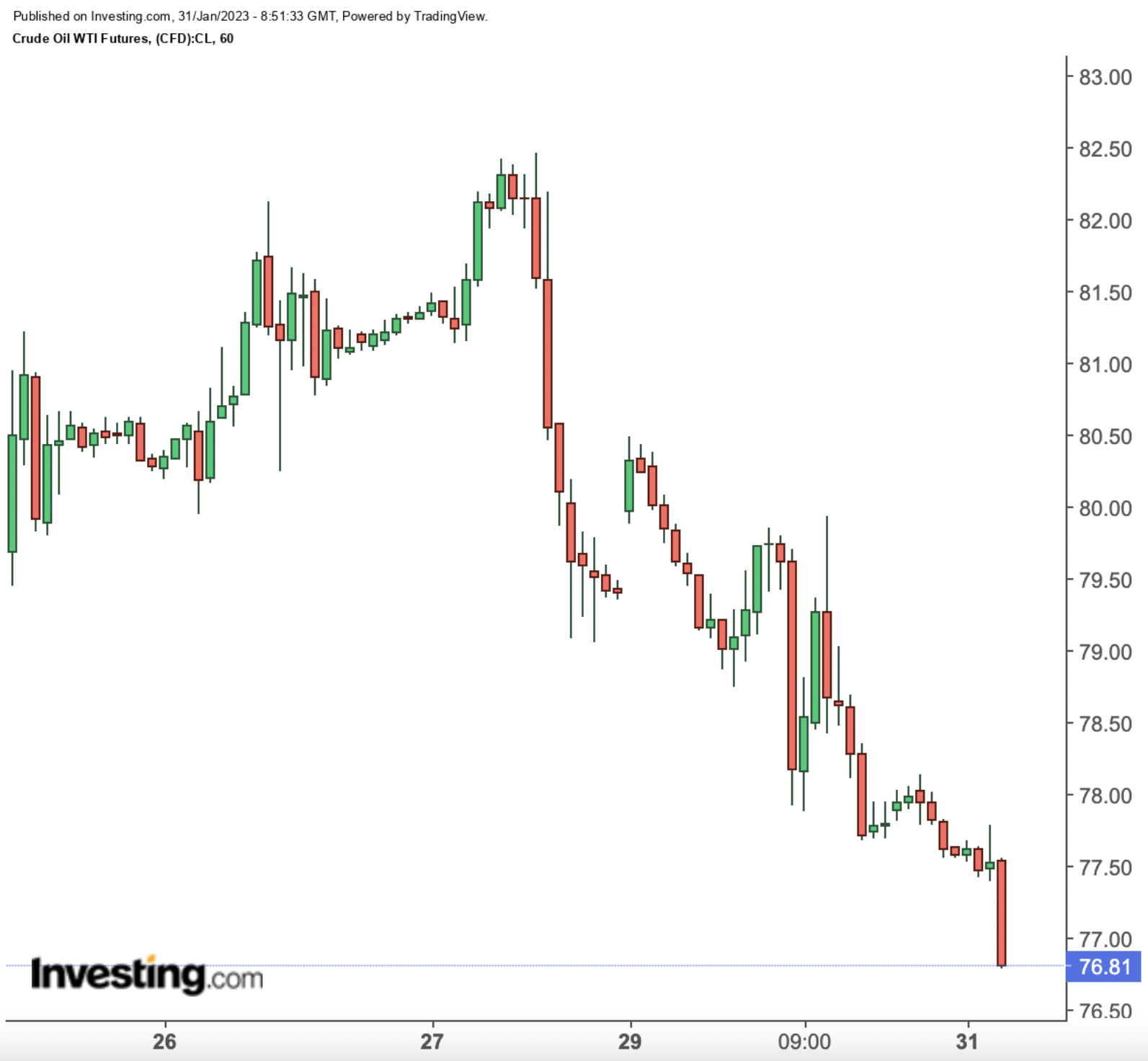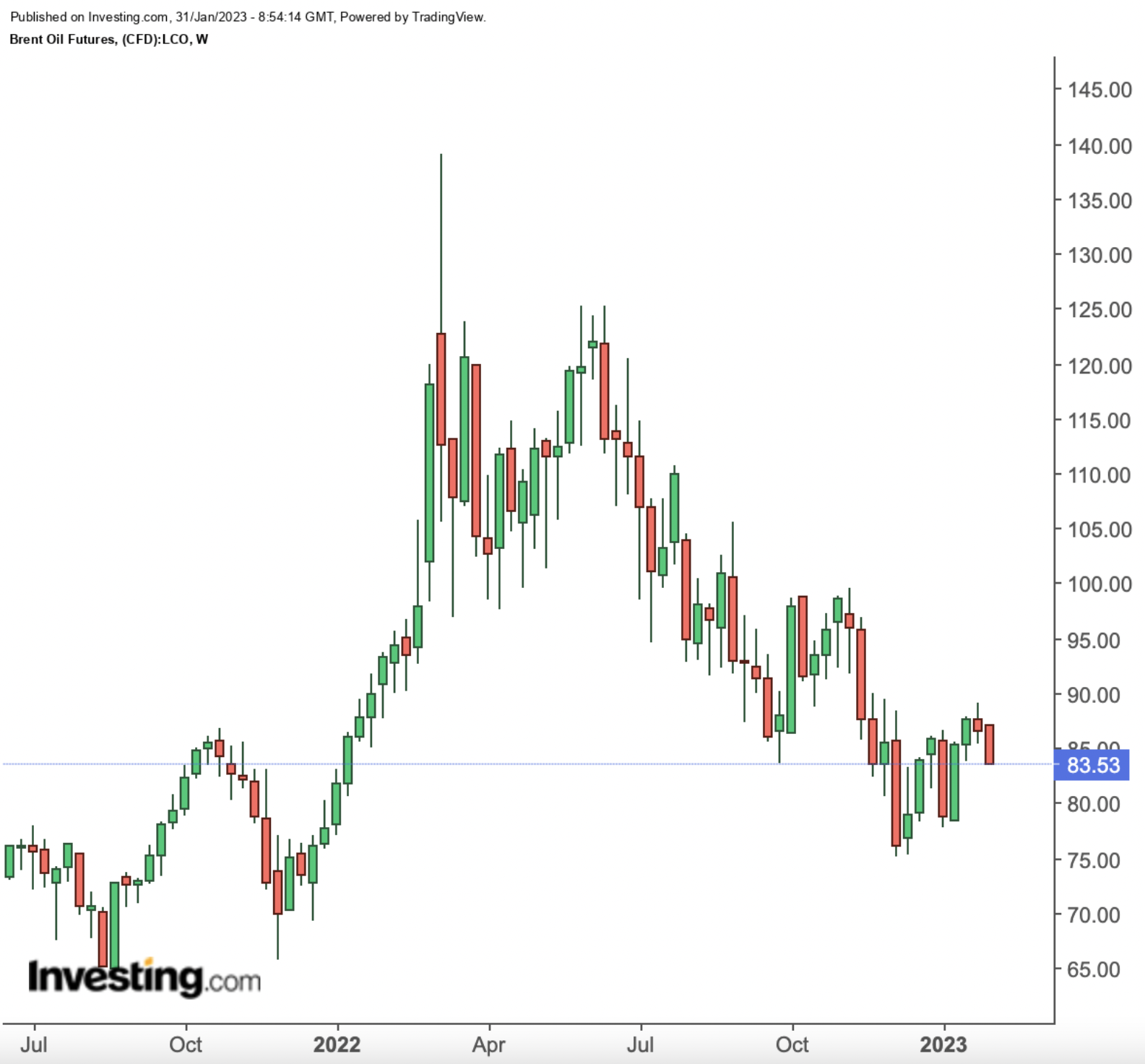- Russia tells Saudis what they want to hear while selling oil at rock-bottom prices
- Moscow’s situation underscores the difficulty of fighting G7’s $60 per barrel price cap
- New caps coming on Russian fuels next, adding to Kremlin’s woes
The third anniversary of the infamous fight between Russia and Saudi Arabia over oil export quotas is approaching.
One could be forgiven for wondering how such a conflict could have even happened with the affection and diplomacy in full display these days between Vladimir Putin and Crown Prince Mohammed bin Salman. Just on Monday, the veteran Russian leader called the younger Saudi royal to assure him of Moscow’s support in maintaining oil price stability, the Kremlin said in a statement.
But the Kremlin indicated on the same day that Putin had authorized Russian oil companies to sell as many barrels at whatever price deemed appropriate to get the country’s heavily-sanctioned crude moving on the global market.
The increased exports of Russian crude at rock-bottom prices — ostensibly to India and China, the only destinations that can receive such sanctioned material — will hurt sales by Riyadh’s state oil company Saudi Aramco (TADAWUL:2222) to the same countries that make up the kingdom’s largest markets in Asia.
Beyond that, they also mess up the Saudis’ aim of keeping a tight lid on supply from OPEC+ — an accomplishment the kingdom’s officials love to talk about, often citing the oil-producing alliance’s compliance of 100% or more with output quotas.
OPEC+, which meets on Wednesday, is expected to leave unchanged production targets agreed upon in December by the 23 nations in its fold. The Russians, who co-chair OPEC+ with the Saudis, are also expected to remind the rest of the group about their commitment to upholding market stability (talk about irony).
The Russian maneuver of giving hope to Saudi Arabia and cheap barrels to India and China underscores the difficulty faced by Putin in fighting the G7’s price cap of $60 per barrel imposed on his country’s oil while trying to live up to Moscow’s own commitments under OPEC+.
The Kremlin, in its statements about Russian oil shipments, made clear that the government “forbids oil exports that adhere to Western price caps.”
But Moscow also indicated that it was allowing Russian private enterprise greater control over exports by saying it “has charged oil companies with overseeing contract wording.”
As though that wasn’t enough, it added a line that was most damning for bulls in the oil market — that “the Russian government has not set a floor price for oil exports.”
It was enough to pull crude prices down 2% by the day’s close after bullish intraday action that took the market up 2% at one point.

John Kilduff, partner at New York energy hedge fund Again Capital, said:
“Decoded, the three messages mean the Russian government’s grandstanding against the West’s price caps remains, while it has opened the backdoor for its oil companies to do whatever is necessary to get their oil moving on the market.
OPEC+ Cooperation
This is a serious problem for the so-called cooperation within OPEC+, which is predicated on its principals Saudi Arabia and Russia keeping exports as low as possible and prices supported at the higher end.”
It hasn’t been an easy partnership for the two since they came together in 2015 to rescue crude prices driven to as low as $26 a barrel at the height of the U.S. shale oil revolution. The Saud-led OPEC, or Organization of the Petroleum Exporting Countries, had 15 members then, and another nine joined Russia in the extended group, making up for a total of 25 under OPEC+. Eventually, two dropped out, leaving the 23-nation coalition we know today.
After relative success in bringing the market back to above $50 a barrel by late 2019 through output cuts, the alliance had the greatest challenge in its six decades when the coronavirus pandemic broke out in March 2020. Sensing the need to tighten production even more, the Saudis proposed severe cuts.
But Putin balked this time on the assumption that Moscow had the economics to live with cheaper oil.
An angry MbS (as the Saudi Crown Prince is known by his initials) then waged an all-out price and production war aimed at not just Russia but also the United States -- which the Arabs saw as the root cause of the market’s destruction via their incessant supply of shale oil that made America the world’s largest producer with a record of over 13 million barrels per day by March 2020.
After U.S. crude plunged to an unbelievable minus $40 a barrel in April 2020, a truce was called, with former U.S. president Donald Trump playing mediator. In just over two years, by March 2022, a week into Russia’s Ukraine invasion, global oil benchmark Brent got to a 14-year high of almost $140 while US crude’s West Texas Intermediate reached above $130.
Fast-forward another year, and oil has new demand concerns as inflationary damages from the pandemic force central banks to adopt the most stringent rate hikes in four decades, threatening economies in the United States to Europe with recession.
WTI is back under $80 this week, while Brent trades below $90. But not all is lost for oil bulls as China’s long-delayed rebound from the pandemic could result in a global record for crude consumption this year, says the Paris-based International Energy Agency — an entity that’s typically bearish on oil.

China Keeping Up With the Bet
At least four Chinese-owned VLCC, or Very Large Crude Carrier, vessels are shipping Russian Urals crude to China as Moscow seeks vessels for exports after a G7 oil price cap restricted the use of Western cargo services and insurance, Reuters reported two weeks ago. A fifth supertanker was shipping crude to India, the report added.
Prior to this, India bought an average of 1.2 million barrels of Russian Urals a day in December, which was 33 times more than a year earlier and 29% more than in November. Discounts for Urals at Russia’s western ports for sale to India under some deals widened to $32-$35 per barrel against Brent when freight wasn’t included, according to a Reuters report from Dec. 14.
Another Reuters report said China paid the deepest discounts in months for Russian ESPO crude oil in December amid weak demand and poor refining margins. ESPO is a grade exported from the Russian Far East port of Kozmino, and Chinese refiners are dominant clients for this.
If that wasn’t enough, a Reuters report from last Friday said Russia’s oil loadings from its Baltic ports were set to rise by 50% in January from December levels. Russia loaded 4.7 million tonnes of Urals and KEBCO from Baltic ports in December. The January surge comes as sellers try to meet strong demand in Asia and benefit from rising global energy prices, the report said.
The Saudis, on their part, have slashed pricing on their own Arab Light crude to Asia to try and stay competitive amid the ruthless undercutting by the Russians — who are supposed to be their closest ally within OPEC+.
Putin may have little choice but to double down on cheap oil sales until China’s demand hopefully lifts Brent to above $90, enabling Moscow to demand more for the Urals it sold to Chinese and Indian refiners.
Tim Ash, a strategist at BlueBay Asset Management, estimates that Putin’s hands have been forced by a budget deficit that could reach about 6% of national income this year. He estimates that Russia’s current account surplus has shrunk after suffering a massive capital flight.
Russia’s revenue from exporting hydrocarbons is already set to halve to about $180 billion this year, says Jacob Nell, one of the authors of a report by Ukraine’s Kyiv School of Economics. Further restrictions would knock a further $40 billion off that figure, with two-thirds coming from lower oil revenues and a third from gas.
Nell says this could push the Russian economy over the edge. The ruble could collapse and inflation soar, leading to bank runs and further capital flight. The government would have to jack up interest rates and cut back spending.
Said Hugo Dixon, a columnist for Reuters:
“The Kremlin could respond with drastic measures such as stringent capital controls or printing money. But these would make the government unpopular, undermining Putin’s government and increasing the pressure to pull back from Ukraine.”
Ultimately, Russia could cushion any blow from lower energy exports by selling some of its central bank reserves that aren’t frozen, said Dixon. But he also suggested it might wait out to see what else the West does.
The G7 will have two more price caps coming into force on Feb. 5 on refined oil products out of Russia. EU officials are considering a cap of $100 per barrel for Russian diesel and a cap of $45 a barrel for Russian fuel oil; sources told Bloomberg.
The European Union will ban imports of refined Russian fuels on Feb. 5, adding to its embargo on seaborne Russian crude oil that began in December.
Bottom Line
No one knows for sure what effect the two new caps on Russian fuel will have on the Kremlin. Whatever the case, China and India may not come to Putin’s rescue on these, Viktor Katona, a lead crude analyst at Kpler, said in comments carried by Markets Insider.
“Both are net exporters of products, so there’s no need for them to be importing more.”
Super discounting aside, the reason India and China have been buying Russian crude like there’s no tomorrow is to process that oil into products, such as diesel, that could be resold to Europe and elsewhere.
The Financial Times pointed out the extent to which the Chinese were going, sending one refined cargo to Latvia, despite the extra time and cost of shipping across such distances.
The Indians even had the impunity of exporting fuel produced from Russian crude to New York via a high-seas transfer at one point, despite U.S. sanctions prohibiting the import of Russian-origin energy products, including refined fuels, distillates, crude oil, coal, and gas.
According to Morningstar Energy and Utilities Strategist Stephen Ellis, a ban on Russian fuels could give both China and India more room to bargain for any supplies they do end up buying.
Price-capped Russian fuels could instead find buyers in Singapore and Fujairah in the United Arab Emirates, then head to larger Asian markets from there, but not the big ones, Ellis added.
Russian products could also flow to West Africa and Latin America, while Europe will likely start sourcing more of its diesel from the U.S. and Asia in a “round of musical chairs,” Katona said.
Russia could also refine less fuel and export even more crude to India and China, he said.
For now, it appears that the Saudis have to count on whatever hope is given to them by the Russians — and pray that Chinese demand kicks in hard enough, as the IEA says, to rise above the threat of recession in the United States and Europe.
OPEC+ has challenging times indeed.
Disclaimer: Barani Krishnan uses a range of views outside his own to bring diversity to his analysis of any market. For neutrality, he sometimes presents contrarian views and market variables. He does not hold positions in the commodities and securities he writes about.
